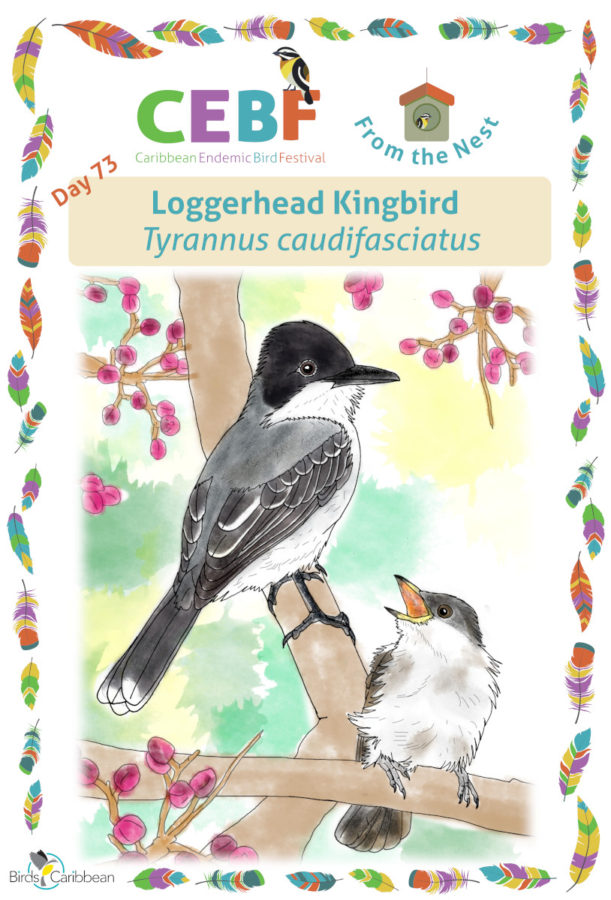Celebrate the Caribbean Endemic Bird Festival (CEBF) with us! Our theme in 2021 is “Sing, Fly, Soar—Like a Bird!” Have fun learning about a new endemic bird every day. We have colouring pages, puzzles, activities, and more. Download for free and enjoy nature with your family at home.
Endemic Bird of the Day: Loggerhead Kingbird
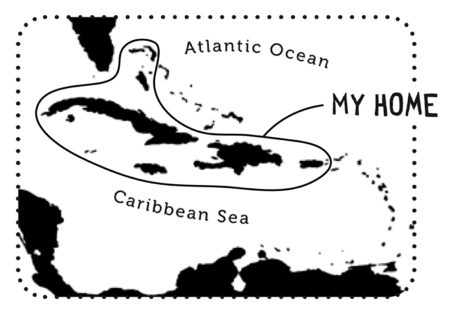 What is that noisy bird? The boisterous, chattering call of the Loggerhead Kingbird (Tyrannus caudifasciatus) can be heard echoing throughout dense coppice forests, pine forests, gardens, settled areas, mangroves, and swamp edges in the Caribbean.
What is that noisy bird? The boisterous, chattering call of the Loggerhead Kingbird (Tyrannus caudifasciatus) can be heard echoing throughout dense coppice forests, pine forests, gardens, settled areas, mangroves, and swamp edges in the Caribbean.
This chunky flycatcher (9.5 -10 inches) has a blackish head with a yellow-orange patch on the crown that only shows when it is excited. It has a dark gray back and wings, accented by whitish edges. The throat, breast, and belly are whitish, with varying amounts of yellow wash. Its square tail is also dark grey with a whitish tip. Juveniles have brownish edges on the wings and no crown patch.
You will always know when the Loggerhead Kingbird is around. It is often seen on exposed perches such as posts, tree branches, and telephone wires. From there, it forages by “sallying” forth – flying out to capture prey, and returning to the same or nearby perch. Its diet mostly consists of insects, berries, small lizards, and amphibians. It builds a cup-shaped, woven nest in the fork of horizontal branches of trees. It will lay 2-4 whitish or salmon-colored eggs, with markings that vary in color in different parts of its range.
The Loggerhead Kingbird is a year-round resident. Endemic to the West Indies, its range extends throughout the northern Bahamas, Cuba, Cayman Islands, Jamaica, Hispaniola, and Puerto Rico. There are seven recognized subspecies, characterized by the amount of yellow wash and the tail pattern. Two subspecies — Tyrannus caudifasciatus taylori of Puerto Rico and Tyrannus caudifasciatus gabbii of Hispaniola — are under consideration to be classified as new species!
At first glance, you might confuse a Loggerhead Kingbird with another Kingbird species. The Eastern Kingbird (Tyrannus tyrannus), a winter migrant to the region, has a bolder white tail band and smaller bill. The Gray Kingbird (Tyrannus dominicensis), a summer migrant to The Bahamas, Cuba, Jamaica, and Cayman Islands, is much paler overall, with a dark face mask and a larger bill. Gray Kingbirds are also much more territorial and aggressive than the Loggerhead Kingbird. The Giant Kingbird (Tyrannus cubensis), which only occurs in Cuba, is a bigger bird with a massive bill and notched tail. Learn more about this species, including its range, photos, and calls here.
Colour in the Loggerhead Kingbird
Download our West Indies Endemic Bird colouring page. Use the photos below as your guide, or you can look up pictures of the bird online or in a bird field guide if you have one. Share your coloured-in page with us by posting it online and tagging us @BirdsCaribbean #CEBFfromthenest
Listen to the song of the Loggerhead Kingbird
The song of the Loggerhead Kingbird is a loud, emphatic trilling, “pit-pit-pit-pit-pit-tirrr-ri-ri-reeee.”
Puzzle of the Day
Click on the image below to do the puzzle. You can make the puzzle as easy or as hard as you like – for example, 6, 8, or 12 pieces for young children, all the way up to 1,024 pieces for those that are up for a challenge!
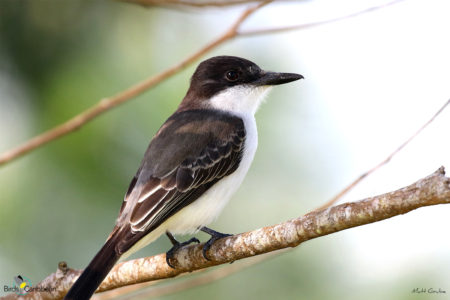
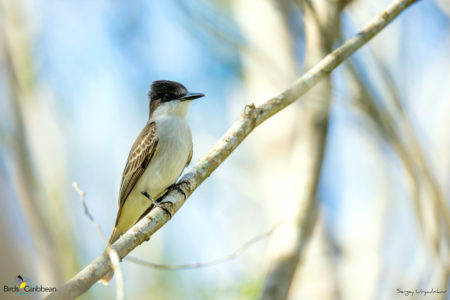
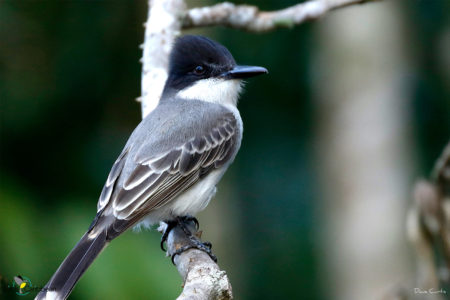
Activity of the Day
FOR KIDS: Can you tell the difference between todays bird, the Loggerhead Kingbird and the other, very similar, types of kingbirds you might meet when out bird watching? Make sure to read our fascinating facts in this post and then test your memory skills in our kingbird matching game ! Be sure to look carefully at the colours, bill sizes, and also the tails of these birds to tell them apart!
FOR KIDS AND ADULTS: Enjoy these videos below showing Loggerhead Kingbirds in their natural habitat! In the first you will see a bird giving the bubbling, chattering calls typical of this species, and you should spot the rarely seen orange-yellow patch on the crown of this bird. The second video shows a Loggerhead Kingbird from the Puerto Rico race, you can see that the tail lacks the white trailing edge seen on this species elsewhere.

